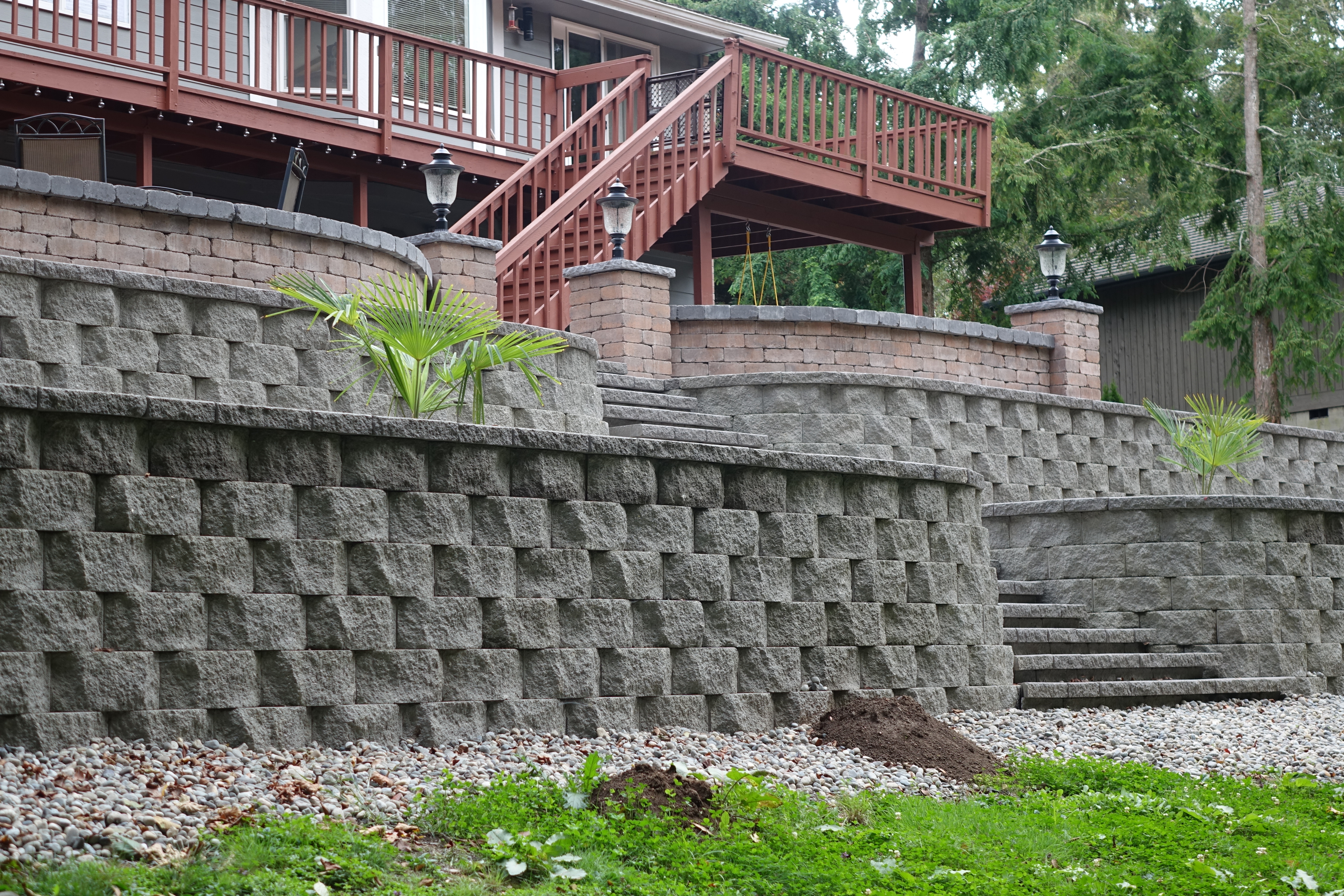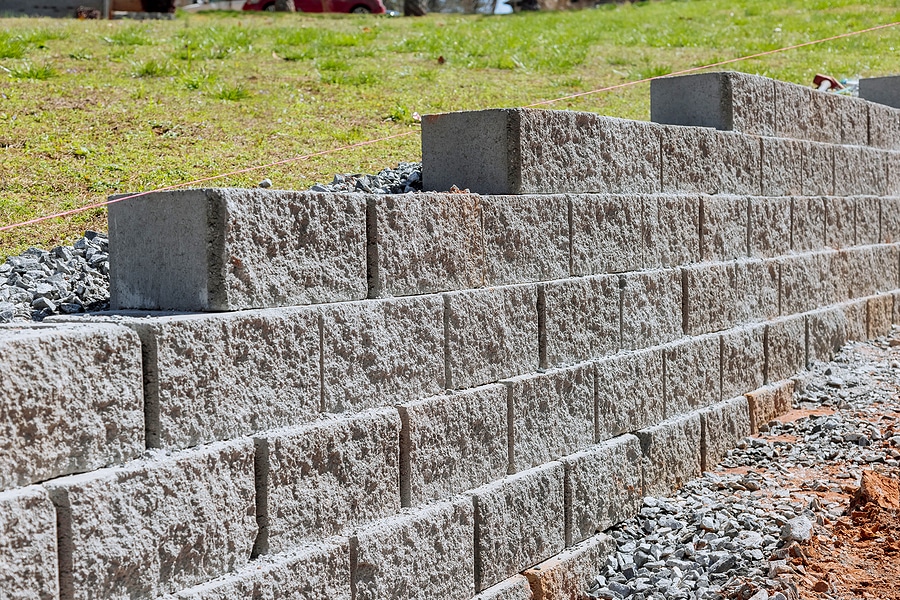Water flow tips to make your OKC Precision Retaining Walls last longer
Key Considerations for Building Efficient Retaining Walls in Your Lawn
When you're thinking about developing a maintaining wall in your yard, it's crucial to think of several crucial factors. The wall's function, the materials you'll utilize, and the specific soil problems can all influence its effectiveness and longevity. You'll also require to browse regional building ordinance and strategy for appropriate drainage. Yet just how do you guarantee your layout not only fulfills these demands but additionally improves your landscape? Allow's explore the important actions together.
Comprehending the Objective of Your Retaining Wall
When you consider building a preserving wall, consider its primary objective: maintaining dirt and stopping erosion. Retaining walls supply essential support for sloped landscapes, aiding to keep soil integrity. You'll locate they're vital in areas where water overflow might otherwise remove dirt, leading to pricey fixings and landscape damages.
By holding back earth, these walls create level surface areas for gardens, outdoor patios, or pathways. This not just improves your backyard's visual appeals however likewise promotes far better water drainage, minimizing water merging in undesirable locations. If you're dealing with steep inclines, a well-constructed retaining wall surface can prevent landslides, guaranteeing security for you and your home.
Ultimately, understanding the purpose of your retaining wall surface will certainly direct your layout decisions and aid you develop a useful, sturdy framework that meets your needs. Take a moment to assess your landscape; it'll pay off in the long run.
Choosing the Right Products
When selecting products for your retaining wall, you'll desire to take into consideration durability, aesthetic appeals, and expense. Each variable plays a necessary role in guaranteeing your wall stands the test of time while looking great and suitable your budget plan. Allow's explore exactly how to make the finest choices for your task.
Material Longevity Factors
Selecting the ideal products is vital for the long life and effectiveness of your retaining wall surface, since their toughness directly impacts the wall surface's ability to withstand environmental stress and anxieties. Begin by considering your regional environment; materials like concrete and rock withstand wetness and temperature variations well. If you reside in an area vulnerable to heavy rainfalls, choose products with great drain properties, like gravel or porous blocks, to stop water buildup.
Additionally, consider the soil problems on your residential or commercial property. Some products do better in certain soil types, so it's crucial to match them accordingly. Be aware of potential wear from bugs or erosion. Selecting resilient products guarantees your retaining wall surface stands strong, protecting your yard for years to come.
Visual Layout Selections
Resilient products not just guarantee your retaining wall's architectural stability but also play a vital role in its aesthetic allure. When selecting the appropriate products, believe concerning exactly how they enhance your landscape. All-natural rock provides a classic, rustic look, while concrete blocks can provide a smooth, modern finish. You could additionally think about making use of wood for a cozy, organic feeling. Shade and structure issue, also; pick shades that balance with your home and yard. Do not forget the wall's form-- curved walls can produce a softer appearance, while straight lines can feel more structured. By very carefully selecting products that straighten with your visual vision, you'll enhance your outdoor room while guaranteeing your wall stands solid versus the components.
Cost-Effectiveness Evaluation
Choosing the ideal products for your retaining wall surface isn't just concerning appearances; it's additionally crucial for your budget. When picking materials, think about both ahead of time costs and long-term durability.
Don't neglect to consider maintenance costs as well (OKC Precision Retaining Walls). Some products, like all-natural rock, can include appeal and call for much less maintenance, while others could require normal therapies
Inevitably, evaluate the pros and disadvantages of each choice against your budget plan and the wall surface's intended function. Investing carefully in materials now can protect against costly issues in the future. Choose materials that balance price and efficiency effectively.
Evaluating Soil Conditions and Water Drainage
As you start your task, reviewing dirt conditions and drain is important for the success of your retaining wall surface. Beginning by examining the kind of soil in your yard. Sandy dirt drains pipes well yet lacks stability, while clay dirt can maintain dampness, causing press on your wall. Test the dirt's wetness content by digging a tiny opening and observing exactly how swiftly it dries out.
Following, evaluate the incline of your backyard. If water naturally streams towards your wall, you'll need to apply a drain remedy to avoid disintegration and pressure buildup. Consider mounting perforated pipelines or gravel backfill behind the wall to facilitate drain.
Lastly, observe any close-by trees or plant life; their origins can impact soil security. By understanding your soil conditions and carrying out proper drain, you'll create a solid structure for your retaining wall surface that stands the examination of time.
Following Local Structure Codes
Before you start constructing your retaining wall, you need to research local laws to guarantee conformity. It's vital to comprehend what allows you need to acquire, as this can conserve you from costly fines or needing to redo your job. Taking these actions seriously will help you build a risk-free and reliable framework.
Research Local Laws
Understanding local laws is crucial when intending your retaining wall surface task, specifically given that constructing codes can differ significantly by place. Begin by contacting your regional building department or municipality to find out about details needs. Try to find guidelines on wall elevation, products, drain systems, and architectural integrity. Many locations have constraints on the kinds of materials you can use and just how high you can construct. You'll also desire to take into account the zoning laws that may impact your project. Neglecting these policies can lead to pricey penalties or the requirement to renovate your work. By doing your study upfront, you can assure your retaining wall surface satisfies all needed codes and blends effortlessly into your yard.
Get Necessary Permits
When you have actually looked into regional policies, the following step is to acquire the necessary licenses for your retaining wall task. This procedure assurances your wall surface complies with building codes and safety and security standards. Reach out to your regional Resources structure authority to figure out what permits you need. They might require details strategies or engineering evaluations, specifically for bigger walls. Be prepared to submit in-depth illustrations, consisting of dimensions and materials. Do not neglect to check if your job impacts water drainage or neighboring properties, as these aspects could call for additional permits. Protecting the ideal authorizations can conserve you from costly penalties or having to dismantle your wall later. Remember, complying with the regulations currently will result in a smoother building and construction experience.

Preparation the Design and Looks
As you commence planning the style and appearances of your retaining wall, take into consideration just how it will balance with the bordering landscape. Believe regarding the products you'll use-- stone, brick, or concrete-- and just how they'll match your home's architecture and the natural components find out this here in your lawn. Select colors and appearances that mix seamlessly with existing features like patio areas, paths, or gardens.
Following, imagine the wall surface's form and elevation. Rounded walls can soften a rigid landscape, while straight lines might convey an extra contemporary appearance. Don't fail to remember to integrate plants and plant around the wall surface for an all-natural touch; this can enhance its charm and integrate it into the atmosphere.
Lastly, bear in mind capability. Your design must not only be visually pleasing but additionally serve its purpose properly. By attentively preparing these aspects, you'll create a keeping wall surface that enhances your backyard's beauty while fulfilling its architectural role.
Calculating Elevation and Thickness Needs
To construct a tough retaining wall, you need to properly determine its height and density needs based on the dirt conditions and the height of the slope it will certainly sustain. Begin by evaluating the slope's angle and the type of soil, as different soils apply differing amounts of stress.
For walls over four feet high, think about a thickness of a minimum of 12 inches. If the wall is taller, boost the thickness proportionally to preserve security.
Following, determine the elevation of the wall surface by determining the upright distance it requires to preserve. For every single foot of elevation, you should commonly intend for a thickness of one-third of the wall surface's elevation.
Constantly keep in mind to make up additional elements like water drainage and backfill, which can affect your wall surface's layout. Correct estimations currently assure your retaining wall surface stands strong and lasts for many years to find.
Upkeep and Durability Factors To Consider
While preserving your retaining wall may feel like a reduced concern, disregarding it can bring about substantial concerns gradually. Routine assessments are necessary; look for fractures, protrudes, or any type of signs of water damage. Addressing these troubles early can conserve you from expensive repair work in the future.
Watch on water drainage systems, also. Blocked drains can create water to develop, putting in pressure on your wall surface and compromising its security. Clear particles and guarantee correct circulation to preserve longevity.
You might also wish to review securing your wall to shield it from dampness and weathering. Depending upon the material, this could need reapplication every couple of years.
Last but not least, landscape design around your wall surface can support its stability. Avoid planting huge trees nearby, as their roots can weaken the structure. With positive maintenance, your retaining wall can serve you well for years to find.

Often Asked Concerns
Can I Build a Retaining Wall by Myself, or Should I Work with a Professional?
You can most definitely build a preserving wall surface on your own if you have the right tools and expertise. Working with a professional assurances it's done appropriately, especially for larger or more intricate frameworks. Consider your ability degree before making a decision.
What Are one of the most Common Errors Made When Structure Retaining Walls?
When constructing retaining walls, you might forget appropriate drainage, miss using the right materials, or overlook support. These usual blunders can result in structural failing, so take your time and strategy meticulously to stay clear of issues.
How Do I Know if My Retaining Wall Needs Reinforcement?
You'll recognize your retaining wall needs reinforcement if you notice cracks, leaning, or bulging. Look for water pooling behind it or soil erosion near the base. Address these indications immediately to avoid over at this website more damages.
What Plant kingdom Are Ideal for Landscaping Around a Retaining Wall?
When landscape design around a preserving wall surface, take into consideration utilizing low-maintenance plants like succulents, decorative lawns, or sneaking ground covers - OKC Precision Retaining Walls. They'll prosper in those conditions and add charm while avoiding soil disintegration around your wall surface
How Can I Prevent Erosion Around My Retaining Wall?
To avoid disintegration around your retaining wall surface, you can plant ground cover, use compost, and mount drain systems. Regularly examine for water build-up and change landscaping to reroute drainage away from the wall.